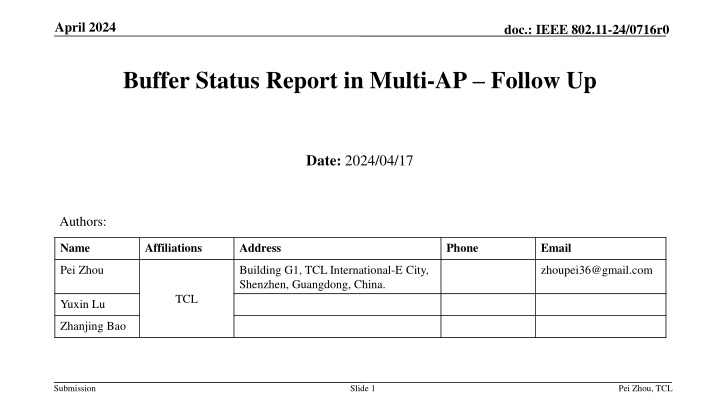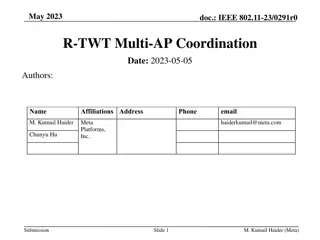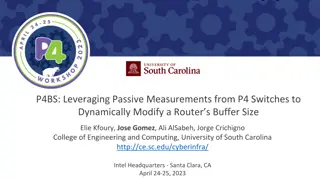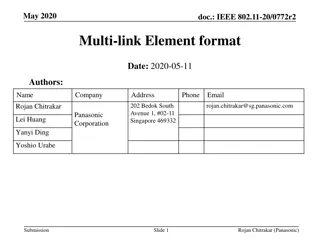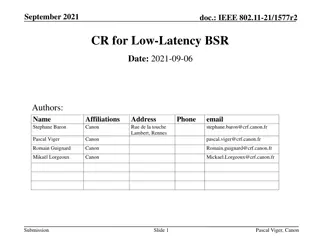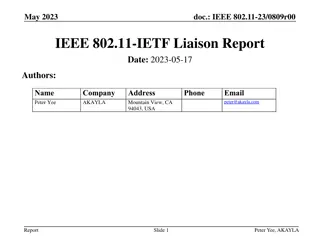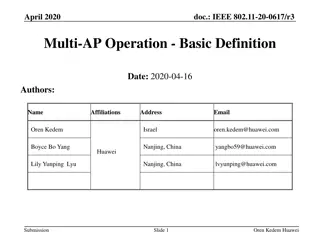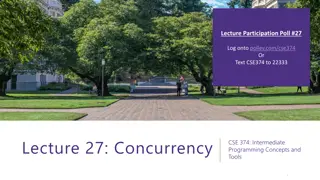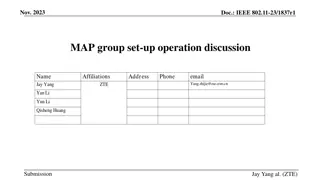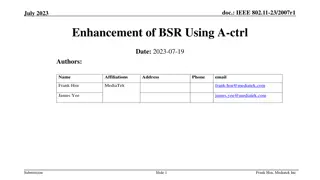IEEE 802.11-24 Buffer Status Report in Multi-AP Coordination
This document discusses methods for obtaining resource needs from shared APs and exchanging Buffer Status Reports (BSRs) in a multi-AP environment. It covers topics such as C-TDMA implementation, C-BSR proposals, and different methods for obtaining C-BSR including Unsolicited and Solicited approaches.
Download Presentation

Please find below an Image/Link to download the presentation.
The content on the website is provided AS IS for your information and personal use only. It may not be sold, licensed, or shared on other websites without obtaining consent from the author.If you encounter any issues during the download, it is possible that the publisher has removed the file from their server.
You are allowed to download the files provided on this website for personal or commercial use, subject to the condition that they are used lawfully. All files are the property of their respective owners.
The content on the website is provided AS IS for your information and personal use only. It may not be sold, licensed, or shared on other websites without obtaining consent from the author.
E N D
Presentation Transcript
April 2024 doc.: IEEE 802.11-24/0716r0 Buffer Status Report in Multi-AP Follow Up Date: 2024/04/17 Authors: Name Affiliations Address Phone Email Pei Zhou Building G1, TCL International-E City, Shenzhen, Guangdong, China. zhoupei36@gmail.com TCL Yuxin Lu Zhanjing Bao Submission Slide 1 Pei Zhou, TCL
April 2024 doc.: IEEE 802.11-24/0716r0 Introduction In [1], we described that the precondition to perform multi-AP coordination is to obtain resource needs from shared AP(s), for example, many contributions proposed to reuse the EHT TXS procedure to realize C-TDMA. In C-TDMA, the sharing AP needs to determine how much time allocate to shared AP(s). other multi-AP coordination schemes (C-SR, C-BF, etc.) may also need to know the resource needs of shared AP(s) in advance. Then, the sharing AP can prioritize inviting the shared AP(s) with low latency traffic to perform multi-AP transmission. In this contribution, we will discuss the following: the method to obtain resource needs of shared AP(s); the format details of carrying shared AP s resource needs. [1] 11-23-1844-00-00bn-bsr-in-multi-ap Submission Slide 2 Pei Zhou, TCL
April 2024 doc.: IEEE 802.11-24/0716r0 Recap of [1] Identified issue: Currently, there is no BSR exchange procedure between APs (e.g., between sharing AP and shared AP). Proposal(s): C-BSR (Coordination BSR) in UHR multi-AP 1. Shared AP can report its C-BSR to sharing AP by the following methods Unsolicited C-BSR Solicited C-BSR (by sharing AP s BSRP Trigger frame) 2. (Shared) AP s C-BSRmay include the following One or more associated non-AP STAs UL buffer status DL buffer status for one or more associated non-AP STAs Both of the above [1] only presented some general ideas without any details [1] 11-23-1844-00-00bn-bsr-in-multi-ap Submission Slide 3 Pei Zhou, TCL
April 2024 doc.: IEEE 802.11-24/0716r0 Methods of obtaining C-BSR (1/4) Method 1: Unsolicited C-BSR Each (shared) AP sends its C-BSR without any solicitation (from sharing AP) AP 1 QoS Null frame or QoS Data frame or Management frame BSR Control field / QoS Control field (Sharing AP) AP 1 QoS Null frame or QoS Data frame or Management frame AP 2 QoS Null frame or QoS Data frame or Management frame (Shared AP) BSR Control field / QoS Control field AP 2 BSR Control field / QoS Control field BSR Control field / QoS Control field . . . BSR Control field / QoS Control field QoS Null frame or QoS Data frame or Management frame . . . QoS Null frame or QoS Data frame or Management frame AP n (Shared AP) AP n Option 1: Each AP sends C-BSR before sharing AP role is confirmed. Each AP uses broadcast or groupcast frame to carry C-BSR. Option 2: Shared AP sends C-BSR after sharing AP role is confirmed. Each shared AP uses unicast frame to carry C-BSR. Note: The procedure of how an AP is confirmed as sharing AP needs further study. Submission Slide 4 Pei Zhou, TCL
April 2024 doc.: IEEE 802.11-24/0716r0 Methods of obtaining C-BSR (2/4) Method 2-1: Solicited C-BSR An (sharing) AP solicits only one (shared) AP to report C-BSR. For example, AP 1 sends an unicast BSRP Trigger frame to AP 2. Key Point: The RA field of BSRP Trigger frame can be set to AP 2 s MAC Address. BSRP Trigger frame AP 1 QoS Control field / BSR Control field QoS Null frame AP 2 Submission Slide 5 Pei Zhou, TCL
April 2024 doc.: IEEE 802.11-24/0716r0 Methods of obtaining C-BSR (3/4) Method 2-2: Solicited C-BSR An (sharing) AP solicits two or more (shared) APs to report C-BSRs. Option 1: AP 1 (sharing AP) solicits other APs (shared APs) one by one. (same as Method 2-1) Key Point: The RA field of BSRP Trigger frame can be set to shared AP s MAC Address. BSRP Trigger frame BSRP Trigger frame AP 1 QoS Control field / BSR Control field QoS Null frame AP 2 QoS Control field / BSR Control field . . . QoS Null frame AP n Submission Slide 6 Pei Zhou, TCL
April 2024 doc.: IEEE 802.11-24/0716r0 Methods of obtaining C-BSR (4/4) Method 2-2: Solicited C-BSR An (sharing) AP solicits two or more (shared) APs to report C-BSRs. Option 2: AP 1 (sharing AP) solicits other APs (shared APs) at once. Key Points: The RA field of BSRP Trigger frame should be set to broadcast address; Then, sharing AP uses AID12 subfield of User Info field to indicate the sharedAPs that need to report C-BSR; Each AP is assigned an APID (e.g., just like AID of non-AP STA) when forming an multi-AP group (or assigned by sharing AP when initiating multi-AP coordination negotiation) Note: So far, no consensus, and further study is needed. Use one reserved bit in Common Info field of BSRP Trigger frame to indicate AID12 subfield of User Info field is redefined as APID subfield . BSRP Trigger frame AP 1 ... QoS Null frame AP 2 QoS Control field / BSR Control field . . . QoS Null frame AP n Submission Slide 7 Pei Zhou, TCL
April 2024 doc.: IEEE 802.11-24/0716r0 Formats of C-BSR (1/2) Based on QoS Control field [2] C-BSR Indicator AP PS Buffer State subfield format An example: The reserved B0 of AP PS Buffer State subfield is defined as the indicator of C-BSR; If C-BSR Indicator subfield = 1, then AP PS Buffer State subfield indicates the buffer state at the AP for multiple (or all) associated STAs; QoS AP Buffered Load may indicate the following 3 options 1. AP s DL buffered load for multiple (or all) associated STAs 2. Multiple (or all) associated STAs UL buffered load for AP 3. The sum of the above two Submission Slide 8 Pei Zhou, TCL
April 2024 doc.: IEEE 802.11-24/0716r0 Formats of C-BSR (2/2) Based on BSR Control field [2] When a frame contains BSR Control field is transmitted from an AP (e.g., shared AP) to another AP (e.g., sharing AP), the receiver (e.g., sharing AP) assumes: the Queue Size High subfield indicates the sum amount of buffered traffic, in units of Scaling Factor octets, for the AC identified by the ACI High subfield that is buffered by the AP identified by the transmitter address of the frame containing the BSR Control subfield for multiple (or all) associated STAs. the Queue Size All subfield indicates the sum amount of buffered traffic, in units of Scaling Factor octets, for all the ACs identified by the ACI Bitmap subfield that is buffered by the AP identified by the transmitter address of the frame containing the BSR Control subfield for multiple (or all) associated STAs. Similar to the previous slide, the Queue Size High subfield and the Queue Size All subfield may indicate the following 3 options 1. AP s DL buffered traffic for multiple (or all) associated STAs Multiple (or all) associated STAs UL buffered traffic for AP The sum of the above two 2. BSR Control field format 3. Submission Slide 9 Pei Zhou, TCL
April 2024 doc.: IEEE 802.11-24/0716r0 Summary We proposed the following methods to share C-BSR between APs Unsolicited C-BSR Solicited C-BSR We proposed the following potential formats of C-BSR Revised QoS Control field Revised BSR Control field We proposed the following potential contents that need to be included into the C-BSR Multiple (or all) associated non-AP STAs UL buffer status DL buffer status for multiple (or all) associated non-AP STAs Both of the above Submission Slide 10 Pei Zhou, TCL
April 2024 doc.: IEEE 802.11-24/0716r0 Q&A of [1] Q1: Requesting resources is more efficient/relevant than exact buffer. A: Requesting resources may have two drawbacks, 1) if the total amount of resources requested by shared APs exceeds what sharing AP can provide, sharing AP doesn t know how to execute the resource allocation; 2) An arbitrary shared AP may request more resources than needed, which will cause fairness issue to other shared APs. In addition to buffer size, C-BSR also contains priority information (i.e., TID / Highest Priority Buffered AC / ACI / ACI High, etc.) of the buffered traffic, which benefits the multi-AP coordination. For example, the sharing AP can prioritize inviting the shared AP(s) with high priority traffic to perform multi-AP transmission. However, only Requesting resources could not achieve this effect. Q2: How does AP-1 (sharing AP) create a resource allocation for AP-2 (shared AP) based on queue size info at AP-2 (shared AP), if it doesn t know MCS, NSS to be used by AP-2 (shared AP)? A: One possible solution is to define a multi-AP coordination negotiation procedure/phase (So far, no consensus, and further study is needed). In this phase, shared AP reports some of its capability information or operation parameters (e.g., MCS and NSS) to sharing AP. Then, sharing AP could determine the multi-AP coordination mode and related parameters (including resource allocation) for shared AP. Thus, sharing AP could estimate the resource allocation for shared AP. Submission Slide 11 Pei Zhou, TCL
April 2024 doc.: IEEE 802.11-24/0716r0 Straw Poll 1 Do you agree to add the following text to the TGbn SFD: TGbn shall define the method to share (Coordinated-)Buffer Status Report (C-BSR) between APs. Y/N/A Submission Slide 12 Pei Zhou, TCL
April 2024 doc.: IEEE 802.11-24/0716r0 Straw Poll 2 Do you agree to add the following text to the TGbn SFD: Sharing AP can use one of more of the following methods to obtain the C-BSR of shared AP: Unsolicited C-BSR Solicited C-BSR Y/N/A Submission Slide 13 Pei Zhou, TCL
April 2024 doc.: IEEE 802.11-24/0716r0 Straw Poll 3 Do you agree to add the following text to the TGbn SFD: The C-BSR of shared AP may contain one or more of the following contents: Multiple associated non-AP STAs buffer status for the Shared AP Buffer status at the Shared AP for multiple associated non-AP STAs Y/N/A Submission Slide 14 Pei Zhou, TCL
April 2024 doc.: IEEE 802.11-24/0716r0 References [1] 11-23-1844-00-00bn-bsr-in-multi-ap [2] Draft P802.11REVme_D5.0 Submission Slide 15 Pei Zhou, TCL
